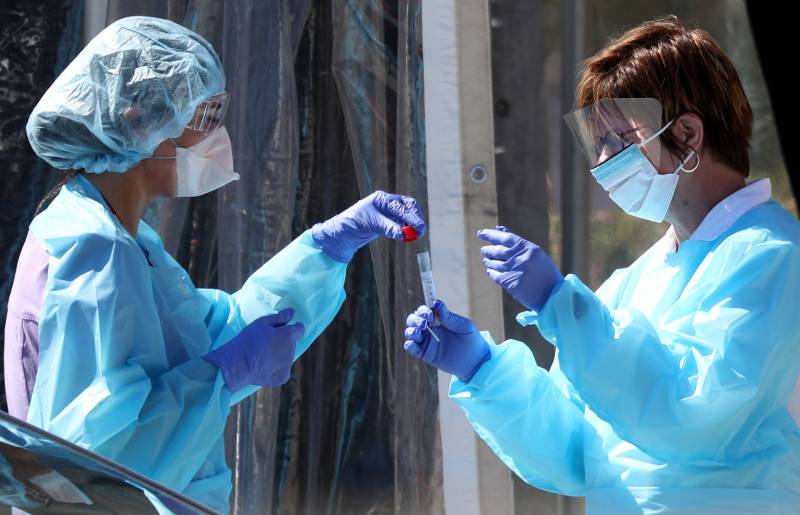The number of confirmed coronavirus cases in California has nearly quadrupled in the past week, from 565 last Monday to more than 2,300, according to the latest counts from California health departments.
Bay Area Hospitals: So Far, Coronavirus Cases Are Manageable. But It's Still Early

Health officials in San Francisco say the number of patients infected with COVID-19 will only escalate over the next two weeks.
“I am sad to have to say that the worst is yet to come,” said Grant Colfax, the city’s public health chief, at a press conference Monday afternoon. “Every community where the virus has taken hold has seen a surge in coronavirus patients who need to be hospitalized. We expect that to happen in San Francisco in a week or two, or perhaps less.”
San Francisco’s major hospitals have logged a steady rise in the number of patients with COVID-19, but they have — so far — been spared the sudden surge of cases that have overwhelmed emergency rooms in states like New York.
New York Gov. Andrew Cuomo says the rate of confirmed cases in that state is doubling every three days and he has ordered hospitals to double their capacity, The New York Times reports.
That sort of influx has yet to hit UCSF’s medical system, said Bob Wachter, chair of the university’s department of medicine, on Monday.
“We’ve heard about the tsunami and we’re kind of waiting on the beach to see what happens,” he said. “We are seeing an increase in cases and nobody should take any of this and say it’s time to go out and party. That is not at all clear, yet.”
Wachter confirmed on Tuesday that the number of incoming cases hadn’t yet changed drastically.
The coronavirus can incubate for two weeks, which means the hospitals are treating individuals who contracted the disease two or even three weeks ago, Wachter says.
“We’ll have a better sense, within the next week, of our ultimate trajectory. But if you look at the curves of the numbers of cases and deaths in New York and compare it to California, it does look like our slope is much more benign than New York.”
Chris Colwell, the medical director of Zuckerberg San Francisco General Hospital, is tracking coronavirus cases closely and has yet to see a “big jump in numbers,” he said Monday, and reiterated Tuesday.
“It is very reasonable to say that — as we sit here today — we have not seen a big surge in patients,” he said. “We’ve seen a steady increase in patients with respiratory issues coming in. The number hasn’t really decreased, but it hasn’t really spiked or increased in a way that we’ve been able to note.”
“We’re always cautiously optimistic,” he said, “and certainly always planning for the worst and hoping for the best.”
In Contra Costa County, the number of cases is “manageable,” says Will Harper, acting communications officer for Contra Costa Health Services, the county’s health department. At Contra Costa Regional Medical Center, a public hospital, there has been no influx of COVID-19 patients to date, he said in an email.
“Keep in mind, this is happening as we are testing more people. CCRMC is preparing for a surge in the near future, which seems inevitable given what we’ve seen happen elsewhere. But, as of now, we haven’t seen a big surge.”
Harper said there were 12 new coronavirus cases in 6 of 8 hospitals in the county as of Monday, with the other two yet to report.
Lucile Packard Children’s Hospital in Palo Alto says it’s “caring for a steady number of patients under investigation for COVID-19.”
“At this time we are not experiencing a spike or surge in the number of suspected or confirmed cases,” Samantha Beal, director of media and public relations, said in an email.
‘We’ll See If These Measures Were Applied in Time’
Dean Blumberg, a professor of pediatric infectious diseases at UC Davis, says he’s hopeful the “extreme social distancing measures” implemented in California have been put in place in time to prevent health care systems from being overwhelmed.
“Obviously, it’s too late in New York because they’re having such a surge in the number of patients,” Blumberg said. “(W)e really won’t know until about two weeks after these measures were put in place. Next week, I think we’ll have a better idea.”
Should no huge surge in coronavirus patients occur, Blumberg says, it doesn’t mean the unprecedented steps California has taken were unnecessary
“That [would mean] that it worked,” he said. “So it’s kind of like you see an accident coming and you slam on the brakes. If you don’t have the accident, that doesn’t mean that you shouldn’t have slammed on the brakes. I mean, you avoided the accident. ”
Stay Home, Save Lives
Even if Bay Area hospitals do not experience a sudden surge in cases in the coming days, officials do not want to see people get lax about the steps they are taking to protect themselves and others. The message from public health officials remains clear: Stay home to save lives.
“At this time we do not have a virus gone wild, but we don’t have anything really effective to treat it besides social distancing and personal hygiene,” said Jeff Smith, county executive officer for Santa Clara, during a Board of Supervisors meeting Tuesday.
“There is no vaccination, which is likely to take many, many months, if at all,” he said. “And there is no treatment drug.”
